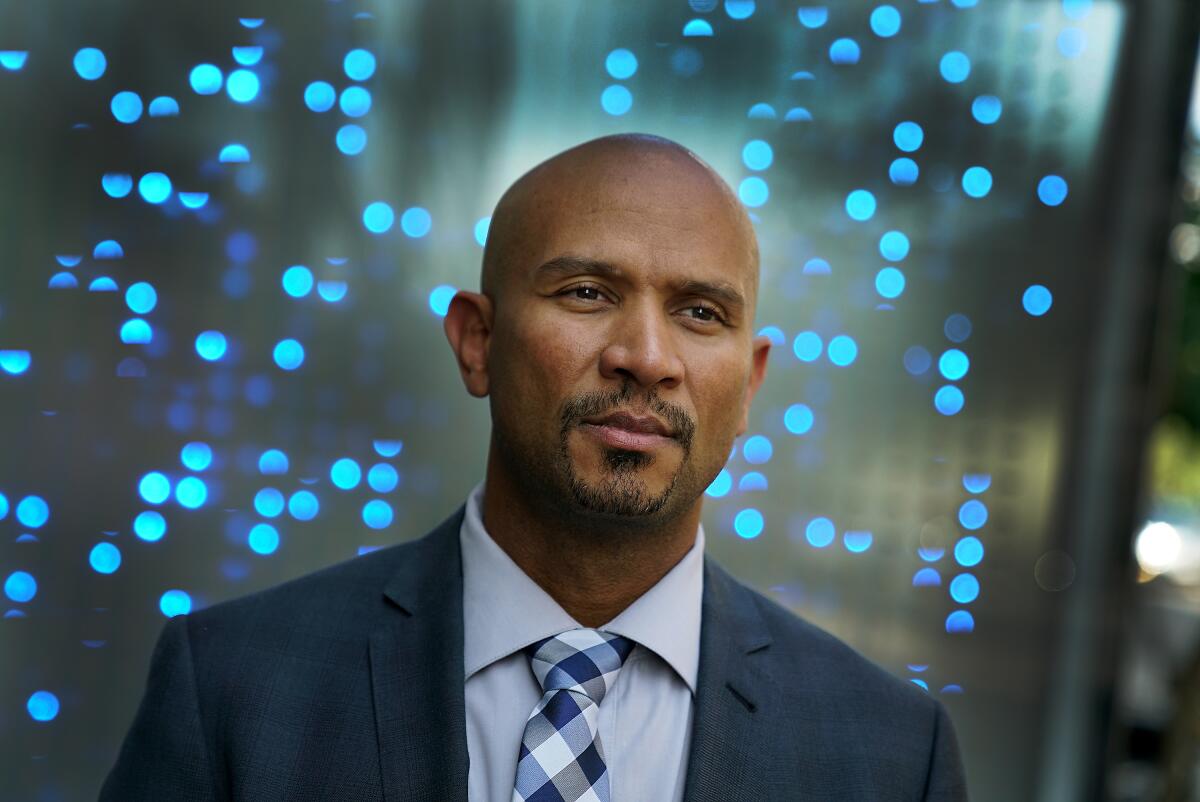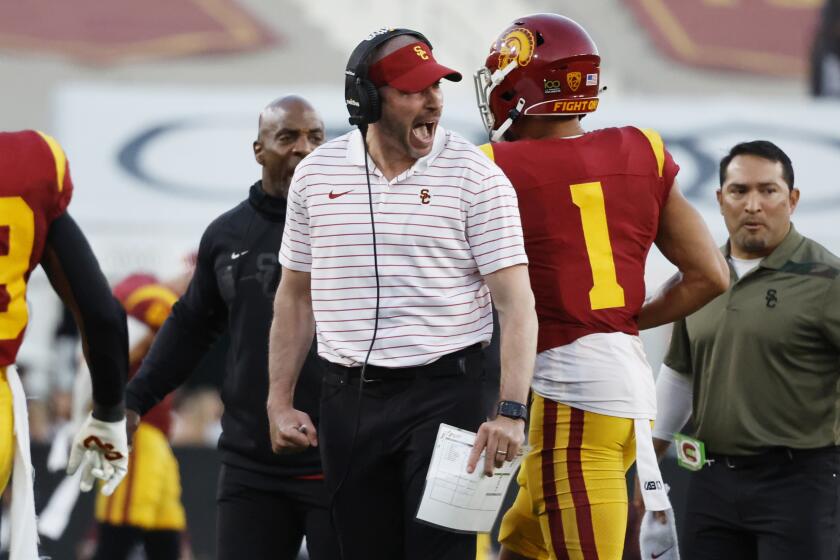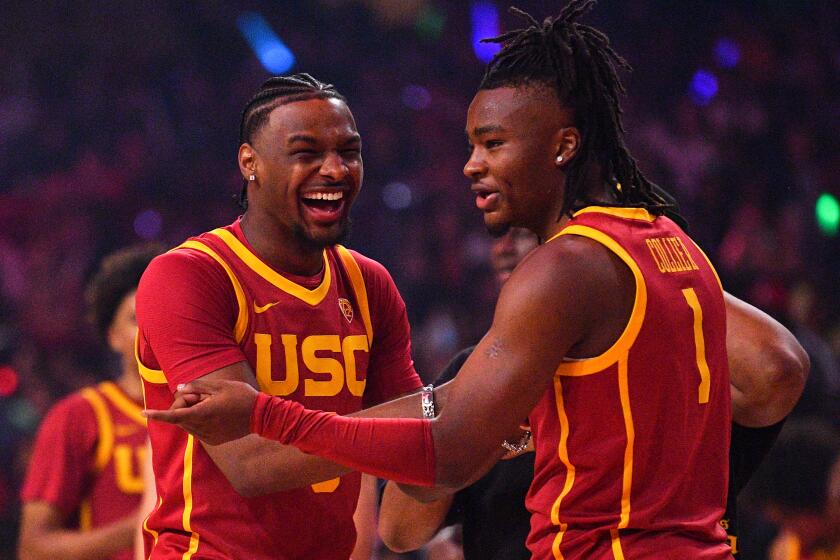Q&A: What USC’s hearing before NLRB could mean for the future of college athletics

- Share via
The battle for college athlete rights is playing out on multiple fronts — federal courts, the halls of Congress, state legislatures and through the National Labor Relations Board.
The NLRB front takes center stage Tuesday in Los Angeles, where the L.A. Region office will hear a case involving allegations that the USC football and men’s and women’s basketball players are employees within the meaning of the National Labor Relations Act. The NLRB has named USC, the Pac-12 and the NCAA as “joint employers” and charged them with misclassifying the players as “student-athletes.”
At issue in the case, brought forward by former UCLA football player and college athlete advocate Ramogi Huma, is whether athletes in these revenue-producing sports should be classified instead as employees.
USC coach Lincoln Riley finally parted ways with embattled defensive coordinator Alex Grinch, but it’s way too late to save the Trojans’ season.
In September 2021, in the months after the Supreme Court ruled in favor of college athletes, allowing them to profit from the use of their name, image and likeness, NLRB general counsel Jennifer Abruzzo issued a statement notifying all field offices she considers “certain players” at colleges to be employees of the institutions for which they play.
In February 2022, Huma, the president of the National College Players Assn., filed separate charges against USC and UCLA, along with the Pac-12 and NCAA. The UCLA charges were dropped — it is harder for the NLRB to establish jurisdiction over a public institution — while the USC charges moved forward.
Here’s what you need to know about the case and its massive potential to force a systemic overhaul of college athletics.
If athletes in these sports become employees of the schools, how will the athletes benefit?

Simply put, they would receive all of the benefits that any employed person enjoys by law — compensation with a minimum wage, social security, overtime, worker’s compensation, other health and safety protections and workplace protections against racial discrimination and sexual harassment.
Players would also have the ability to unionize and collectively bargain with the schools for improved conditions.
“Right now if the players decide to bargain, the employer doesn’t have to bargain in good faith,” Huma said. “They can wrongfully terminate college athletes’ opportunities without the players having any recourse. It puts them in a better position to try to bargain collectively.”
How do the schools feel about the issue? Should I be skeptical of what the schools say?
The NCAA’s doomsday scenario has always been that college athletes become employees, forcing the schools to share revenue with the players that has traditionally gone toward coaches and administrator salaries and new facilities.
The schools, the Pac-12 and NCAA are expected to refute the NLRB general counsel’s position, arguing that referring to USC athletes as employees would cause conflicts complying with Title IX, immigration laws, IRS policy and state workers compensation laws. They have also called it a potential 1st Amendment violation, forcing them to endorse a new label for athletes they do not agree with.
The groups are asking Congress to save them with a law that specifies athletes are not employees.
During a recent U.S. Senate hearing on the future of college sports, Huma was a panelist and was frustrated at the way he heard the issue being painted — but not surprised.

“There was a pointed effort to cast employee status as bad for college athletes,” Huma said. “It wasn’t an accurate description of the realities that are before us.”
For one, Huma said, speakers at the hearing were talking about Division II and Division III athletes or nonrevenue sport Division I athletes also being classified as employees and forcing the cancellation of programs at all levels due to the expense. But the NLRB case only focuses on USC football and men’s and women’s basketball.
“They say, we talk to a lot of college athletes, they don’t want to be employees,” Huma said. “Well, what are you telling them? It was the same thing with NIL, that it would lead to sports being cut, that once boosters start paying the players, we won’t have enough money for the other sports. To date, after two years of NIL, I haven’t heard of any schools cutting sports due to diversion of NIL funds.”
At one point in the hearing, Sen. Ted Cruz (R-Texas) expressed shock at the idea of college athletes being fired.
USC basketball tips off its season Monday against Kansas State and is expected to contend for a Pac-12 title and run in the NCAA tournament.
“Our position is that players can already be fired and are,” Huma said. “Look at Deion Sanders at Colorado. Deion announced it prominently in the press that he was going to run [players] off. A.K.A., he was going to fire them. There’s no wrongful termination, no protection in that process.”
It should be noted that the same schools and coaches that are up in arms at the transfer portal could be able to set limits on the portal through collective bargaining.
Why will this be different than when Northwestern football players tried to unionize?
Huma was also a key adviser to Northwestern football players who attempted to unionize in 2014. In that case, the regional office ruled the players to be employees, but the national office did not assert jurisdiction.
“At Northwestern we had to break new ground at that time in a more hostile public opinion environment with no precedent,” Huma said. “Between the Supreme Court, the Jennifer Abruzzo memo that came just after the decision, Congress really is the NCAA’s last hope in terms of trying to carve players out of employee status. If you treat players equally under labor law, they’re clearly employees of the schools.”
What structure will the hearings take on and when will they be completed?
This week’s hearings will focus on pretrial motions and subpoena issues. No testimony will be heard until Dec. 18-20. The hearing could last into late February if necessary.
If the regional office confirms the original charges, the case will move onto the national office.
More to Read
Fight on! Are you a true Trojans fan?
Get our Times of Troy newsletter for USC insights, news and much more.
You may occasionally receive promotional content from the Los Angeles Times.









